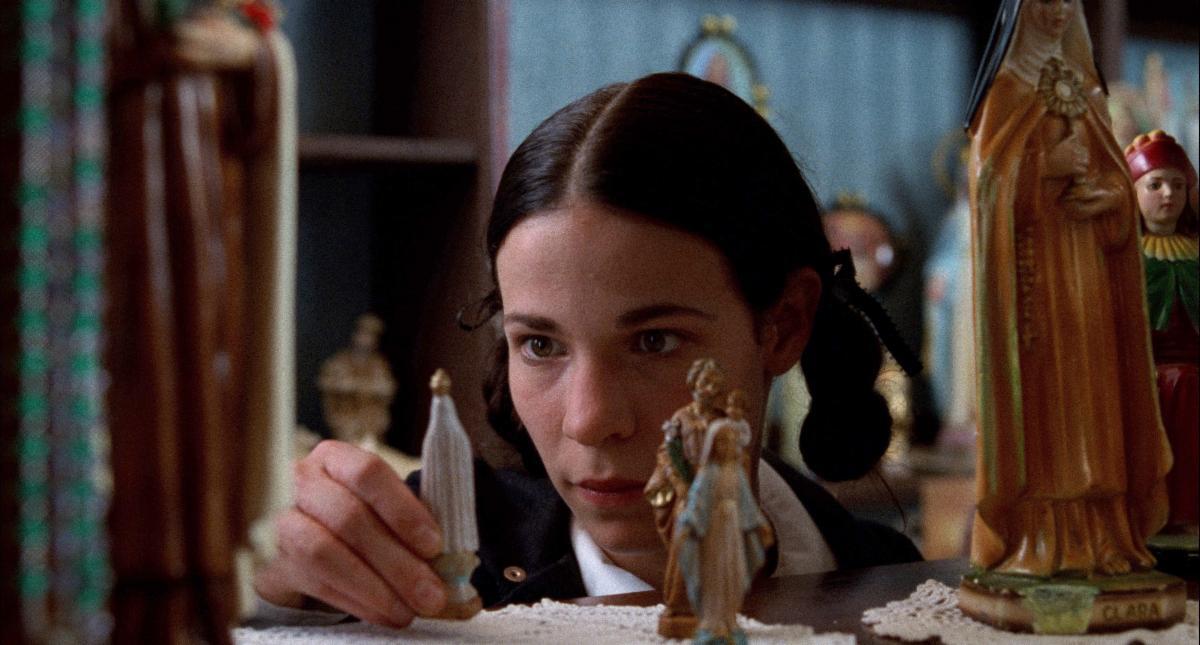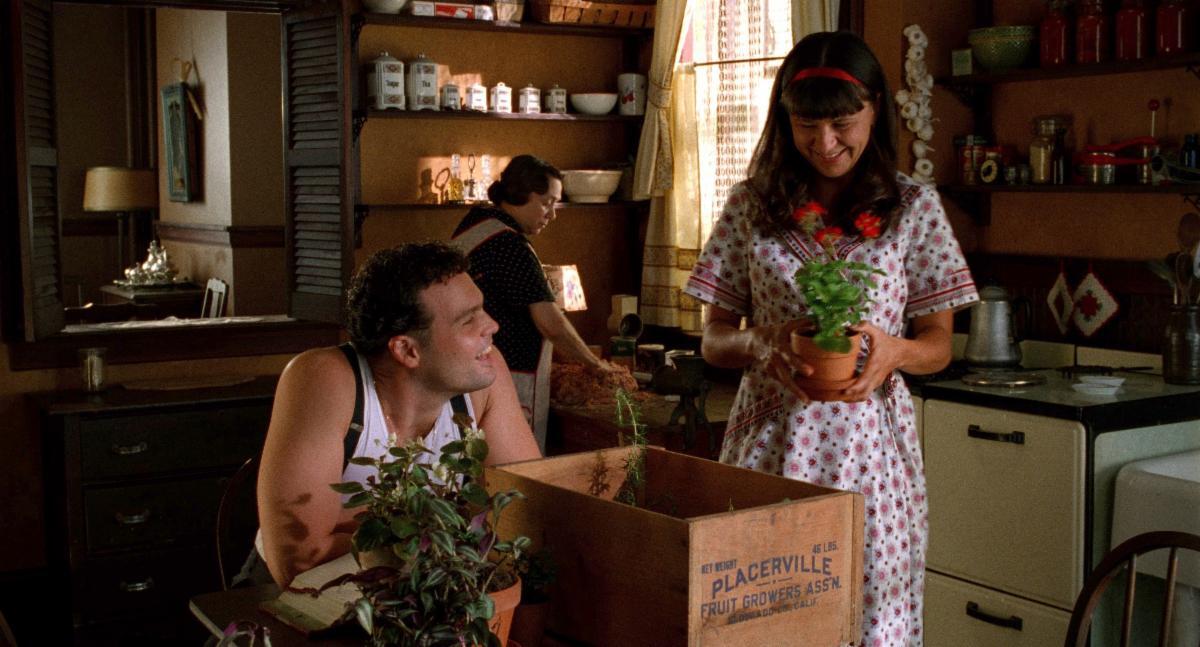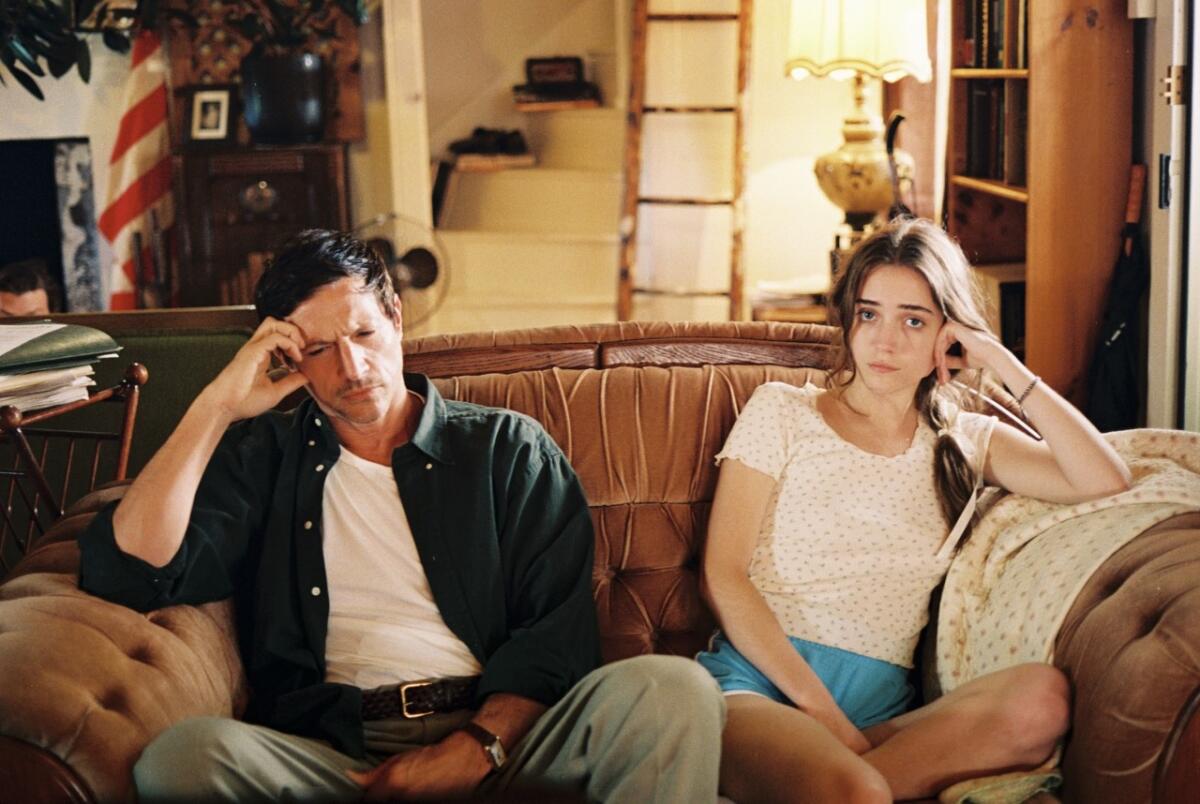Nancy Savoca on the small miracles of ‘Household Saints,’ plus the best movies in L.A.

- Share via
Hello! I’m Mark Olsen. Welcome to another edition of your regular field guide to a world of Only Good Movies.
This has been an extremely eventful week, including (in happier news) the ongoing Sundance Film Festival and the nominations for this year’s Academy Awards.
At Sundance, photographer Mariah Tauger captured the talent moving through the L.A. Times photo studio.
Jen Yamato spoke to Will Ferrell and Harper Steel about the documentary “Will & Harper.” Among those Jen also spoke to were Megan Park, Maisy Stella, Maddie Ziegler, and Kerrice Brooks about the film “My Old Ass” and Jay Will, Camila Cabello and Chiwetel Ejiofor with “Rob Peace.”
Joshua Rothkopf and our video team captured chats with, among many others, Saoirse Ronan, Laura Linney, Kristen Stewart and the family of Christopher Reeve.
On the Oscar noms front, Justin Chang ranked all 10 best picture nominees, while Glenn Whipp took a look at the snubs and surprises of that morning.
Nancy Savoca’s ‘Household Saints’

Directed by Nancy Savoca and adapted by Savoca and her husband Richard Guay from the novel by Francine Prose, 1993’s “Household Saints” has gotten a new restoration and re-release. The film is playing tonight at the American Cinematheque’s Los Feliz 3 with Savoca and Guay in person for a Q&A.
The Cinematheque will also have other showings of “Household Saints” along with Savoca’s 1989 debut feature “True Love,” which won the grand jury prize at the US Film Festival (as Sundance was called before rebranding in 1991), as well as her follow-up film, “Dogfight.” It was “Dogfight” that first paired Savoca with performer Lili Taylor, who would have another winning turn in “Saints.”
“Household Saints” is a wonderful artifact of early-’90s independent filmmaking, with Savoca acting almost as a regionalist ethnographer of Italian-Americans living in New York City. A mismatched couple, Catherine and Joseph (played by Tracey Ullman and Vincent D’Onofrio) run a family butcher shop best known for their sausages. Their daughter, Teresa (Taylor), becomes deeply religious, enraptured by the story of Saint Therese, known as the Little Flower, who she begins to model herself after, upending all of their lives. Michael Imperioli, Michael Rispoli, Victor Argo and Illeana Douglas are part of the deep cast.
In his original Times review of he film, Peter Rainer wrote, “Most movies are locked into a single mood from the first shot but ‘Household Saints,’ directed by Nancy Savoca from Francine Prose’s novel, moves gracefully from knock-about high spirits to a kind of austere sublimity. It’s a difficult movie to get a fix on, but the difficulty is what makes it special.”
In a recent call from her home in New York, Savoca said it had been a wonderful experience to revisit the film for the restoration.
“It was just like this beautiful getting-to-know-you-again movie,” Savoca said. “It’s like having your kid come back to live with you. It’s like, Oh, where have you been?”
Can you talk about the restoration process itself, how you came to recover the rights and film elements to the movie in the first place?
We were part of that movement in the ’90s where companies, big distributors, were seeking content for home video. So all kinds of things were happening, but they weren’t necessarily financing the movies. So all these companies popped up, some of them overnight with a card table that then they’d fold and leave and disappear. And we just doing whatever needed to happen to get the movies to exist. And somewhere along the line, we just understood — and this is where our issue was — we always understood that when we signed [with a distributor] that the movie no longer was ours. We just went along with it. So it never occurred to us once we made the movie. We just tried to figure out how to make the next one. Until one day you turn around and it’s like, “Oh, do you have a print of your movie to show?” And we’re like, “Wow, we don’t.” And that was the big wake-up call we had.
I’m that kind of person that, whenever I have a problem, if it’s my problem, I try to figure out how I got there and how to solve it. But if it’s a problem that I notice other people are having [as well], then that’s a big problem. And then with Dennis Doros and Amy Heller [of Milestone Films] and several other filmmakers, including Mary Harron and Mira Nair, we formed a group called Missing Movies to educate the public about why their favorite movies are not here. And also to educate filmmakers today saying: Hey, start preserving your films now. There are very basic things you can do even if you don’t have a big budget, to just start that preservation process, so that you don’t lose track. It’s been quite a journey.

Can you talk a little bit about how you approached the movie’s depiction of religion? The movie is very respectful.
I think Francine had it in the book — a genuine curiosity, spiritual curiosity. We didn’t really deeply talk about each other’s spirituality, but I feel like she got a lot of what I had growing up, that little girl. I had a lot of what that little girl had, and because I think if you experience it and you understand it, I think there’s an empathy there that’s kind of different. I’ve done satire too, and when you aim at somebody with a dart, it’s a little bit different. And if you’ve been there, then there’s that curiosity and you’ll still see humor in it. You’ll still see stuff that’s really funny. And I think that to me, my family’s Argentinian and Italian, so you could be suffering one moment and laughing the next. And that’s also very Jewish. I think there are a lot of cultures that have this, that kind of laugh-cry thing that you can do. I think this movie does that. And I feel really comfortable with it. So to me the spirituality is because I feel it. I get it.
Jonathan Demme was an executive producer on “Household Saints” and you worked with him on some of his own films. What was that relationship like?
We worked on “Something Wild” with him and then “Miami Blues.” He was a huge supporter. He invested in “True Love.” We called them the celebrity investors. Susan Seidelman was another one. John Sayles was another one, that invested a little bit of money and then we were able to tell the regular investors, “Hey, you know, these filmmakers believe in this project.” So that’s how we got that funded, thanks to them. And then I ended up being his neighbor for 13 years because we moved up to where he lived, the house next door. We had no idea who lived there. And he was just amazing, wonderful. Opened up a back fence so that our kids could play with each other. That’s how cool he was as a neighbor.
His love for movies, his enthusiasm was super contagious. He came down to set just to visit. He said, “If you need anything from me, I’m here, but if you don’t need anything, I know you got this.” And I hope I’m not conflating the dates, I think this is correct, that he was doing “Philadelphia” and at one point brought over his dailies for us to watch in my living room together. And I just remember at one point the scene where Tom Hanks is listening to opera and it’s an overhead shot that moves around him as he’s listening to opera. And when they say “cut” and it’s such a special loaded moment, and then I hear Jonathan’s voice going, “Fantastic!” And he was just like this cheerleader, the best cheerleader you could want on your side. And that’s how he was with everyone.
Other points of interest
‘The Sweet East’ in L.A.

As a cinematographer on films for the likes of Alex Ross Perry and the Safdie Brothers, Sean Price Williams has become known for his distinctively textured and lively images. Now he expands on that sensibility with his debut as a feature film director with “The Sweet East,” written by film critic Nick Pinkerton and starring Talia Ryder, Simon Rex, Jacob Elordi, Jeremy O. Harris and Ayo Edebiri.
The film is an exciting, purposeful provocation for tumultuous times. A high school student, Lillian (Ryder), becomes separated from her classmates while on a trip to Washington, D.C., and finds herself on a journey through the dark heart of America, encountering factions from all sides of the political spectrum.
“The Sweet East” will be opening this weekend at the Nuart, with a Friday night L.A. premiere presented by Mezzanine. Williams, Ryder and Rex will be appearing for Q&As at various showtimes, with “Red Rocket” filmmaker Sean Baker moderating Saturday night. The film will also have a limited engagement at the American Cinematheque’s Los Feliz 3 starting on Feb. 2.
Gus Van Sant at Vidiots
Filmmaker Gus Van Sant is making the rounds to promote his new TV series “Feud: Capote vs. the Swans,” which he directed. He’ll be stopping by Vidiots on Sunday for a special double-bill of two of his very best films. Van Sant’s 1989 breakthrough feature “Drugstore Cowboy,” starring Matt Dillon as an addict and petty thief, will play along with 1995’s “To Die For,” starring Nicole Kidman as an aspiring newscaster. The director is scheduled to be there in person for the screening of “Drugstore Cowboy,” which has already sold out, but there will be limited walk-up tickets available.
In Sheila Benson’s 1989 review of “Drugstore Cowboy” — which also originally opened locally at the Nuart — she called the film “an electrifying movie without one misstep or one conventional moment. … Because it’s a pretty limited world, airless and crushingly dumb, in which the impulse is simply to move from high to high, the wonder is that a movie this alert, this razor-funny and this compulsively watchable, can be made about it without betraying its blitzed-out characters. Somehow, in only his second feature, director and co-writer Gus Van Sant has managed it.”
Kristin McKenna’s 1989 profile of Van Sant captures a filmmaker experiencing the first flush of attention from Hollywood proper. “Sure there are people chomping at the bit to give me big bucks right now, but they won’t give me money to make my next movie, they’ll give me money to make a movie,” Van Sant said.
In Kenneth Turan’s 1995 review of “To Die For,” he called the film “the most accurate assault against the media age since ‘Network,’” adding, “Told with a panache that extends from the opening credits to its closing frames, ‘To Die For’ plays its themes for everything they’re worth, and, regrettably, they seem to be worth more every day.”
Only good movies
Get the Indie Focus newsletter, Mark Olsen's weekly guide to the world of cinema.
You may occasionally receive promotional content from the Los Angeles Times.




